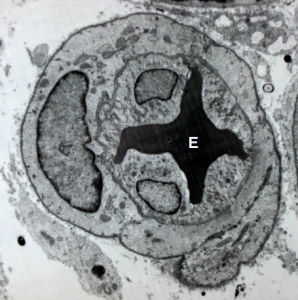[retweet][facebook]
A recent study reveals that acupuncture has a curative effect on patients with cerebral vasospasm. This is a severe vasoconstriction of arteries and is located in the subarachnoid cavity covering the brain. The vasospasm decreases blood flow to the area and may cause ischemia, infarction, stroke and death. This new research demonstrates that combining acupuncture, herbal medicine and pharmaceutical medication together is significantly more effective than using only drugs.
 During a randomized controlled trial, researchers divided 60 patients equally into a control group and an acupuncture treatment group. Patients in the control group received conventional medication. Patients in the acupuncture treatment group received the same medication as the control group plus acupuncture and the Traditional Chinese Medicine (TCM) herbal formula Xue Fu Zhu Yu Tang (Decoction for Driving Out Blood Stasis in the Blood Mansion). After 4 weeks of treatment, the outcome of the acupuncture treatment group was better than that of the control group and the difference was statistically significant (P<0.05).
During a randomized controlled trial, researchers divided 60 patients equally into a control group and an acupuncture treatment group. Patients in the control group received conventional medication. Patients in the acupuncture treatment group received the same medication as the control group plus acupuncture and the Traditional Chinese Medicine (TCM) herbal formula Xue Fu Zhu Yu Tang (Decoction for Driving Out Blood Stasis in the Blood Mansion). After 4 weeks of treatment, the outcome of the acupuncture treatment group was better than that of the control group and the difference was statistically significant (P<0.05).
TCM Perspective
Generally, cerebral vasospasm is commonly a response to an aneurysmal hemorrhage. Symptomatic cerebral vasospasm often occurs when an atherosclerotic plaque in the internal carotid or vertebral arteries narrows the lumen. This leads to the dysfunction of cerebral vessels. According to Traditional Chinese Medicine (TCM), symptomatic cerebral vasospasm is often listed in the headache category and is usually caused by a weak constitution plus the influence of exogenous pathogenic factors. The vasospasm leads to yang qi deficiency that causes blood to flow outside normal pathways eventually leading to blood stasis in cerebral channels.
The Experiment
In this study conducted by the neurosurgery department of Shanxi People’s Hospital, the patients’ courses of disease ranged from 48 hours to 2 weeks. TCM diagnostics confirmed these patients’ symptoms belong to the category of stasis blocked tracts. Both the control group and the acupuncture group took comprehensive therapeutic measures addressing dehydration, hemostasis and prevention of gastrointestinal bleeding. Patients of the control group received nimodipine via intravenous pump at the rate of 2-4 ml per hour for 2 weeks. Next, they received oral administration of nimodipine for 2 weeks. Nimodipine is a calcium channel blocker used to prevent complications from a subarachnoid hemorrhage related vasospasm.
In addition to the medications used in the control group, the acupuncture group received needling at acupuncture points GV23 (Shangxing), DU20 (Baihui), EX-HN3 (Yintang), LI15 (Jianyu), LI11 (Quchi) and GB34 (Yanglingquan). The acupuncture needles were retained for 20-30 minutes and manipulated once after 15 minutes. Acupuncture treatment was administered once a day for a course of 14 days. In addition, a formula based on Xue Fu Zhu Yu Tang was used and contained the ingredients Chi Shao 6g, Chuan Xiong 9g, Tao Ren 9g, Hong Hua 9g, Dang Gui 12g, Shui Niu Jiao 15g, Gou Teng 9g, Niu Xi 12g, Chai Hu 9g, Zhi Ke 6g, Jie Geng 6g and Sheng Di 12g. The formula was administered once per day for 2 weeks, comprising 1 session.
Superior Patient Outcomes
After 4 weeks of treatment, the overall effective rate for the acupuncture treatment group was 76.67% compared to 60.00% for the control group. According to the X2 test, the outcomes were statistically different (P<0.05), demonstrating that acupuncture combined with herbs and conventional medication is superior to conventional medication alone in treating cerebral vasospasm. The added benefit of combining acupuncture and herbal medicine therapeutic care to the biomedical treatment regime suggests that expansion of integrative medicine in conventional medical settings promotes improved patient outcomes in cases of cerebral vasospasm.
The results demonstrate that acupuncture quickly relieves cerebral vasospasm by improving cerebral blood flow. DU23, DU20 and EX-HN3 are acupoints on the Du Meridian. According to TCM principles, these acupuncture points are capable of restoring consciousness and regulating the Shen (spirit, emotions). The acupoints LI15, LI11 and GB34 synergistically work to relax tendons and activate vessels. Widely used in the treatment of ischemic cerebrovascular disease, Xue Fu Zhu Yu Tang invigorates blood circulation and disperses blood stasis. In addition, Xue Fu Zhu Yu Tang inhibits platelet aggregation and the formation of thrombus, improves microcirculation, dilates cardiac and cerebrovascular vessels and reduces oxygen consumption.
This study represents a multi-pronged approach to treating cerebrovascular spasm. Biomedical pharmaceutical medications are administered per conventional medical standards. Next, two branches of TCM are applied, acupuncture and herbal medicine. The theoretical principles for the choice of acupuncture points and herbal medicine stem from a singular TCM differential diagnosis. Acupuncture and herbal medicines are often used separately. The combination of these two application modalities is often employed to provide a synergistic medicinal effect.
Many research investigations are strictly reductionist and investigate one herb, one pharmaceutical medication or one acupuncture point. The approach taken by this investigational team reflects current standards in TCM in the modern clinical setting. This real-world approach accurately reflects a standard of care delivered in TCM hospitals and reflects a model of care optimized for superior patient outcomes.
Excerpt from:
